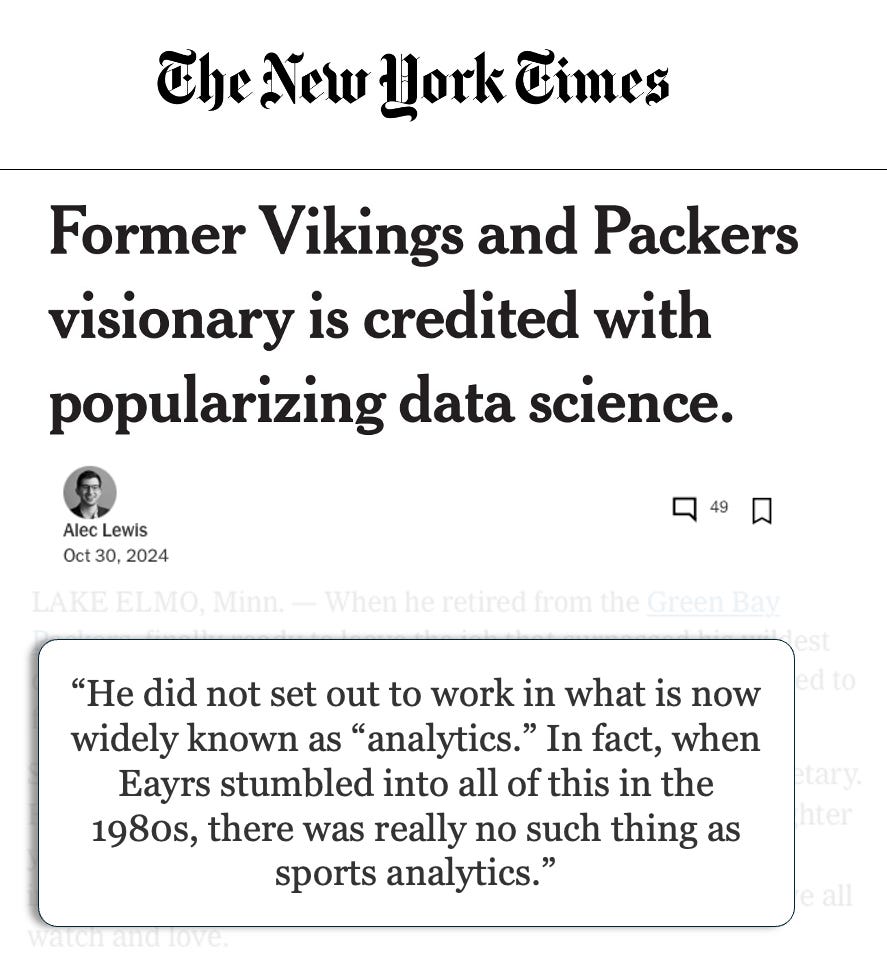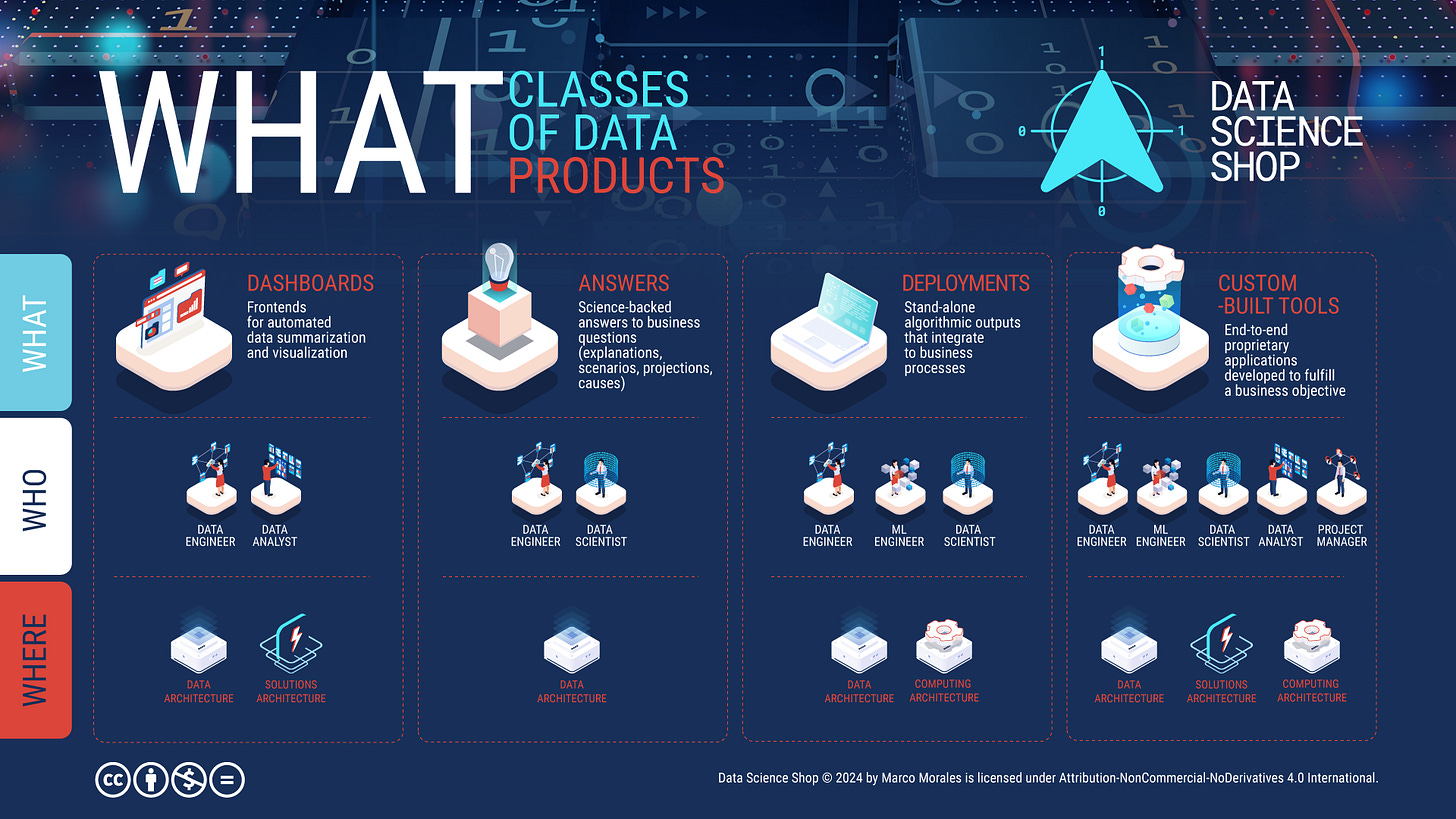no, Data Science is NOT Analytics! This is why.
Analytics identifies trends, Data Science builds Data Products
TL;DR
Analytics and Data Science are often used interchangeably, but they are distinct disciplines.
Analytics focuses on identifying and interpreting trends in data, while Data Science builds Data Products to solve needs or problems in a business.
Understanding the difference is crucial for effectively leveraging data in organizations.
The New York Times recently published the story of Mike Eayrs, one of the early systematic users of data in the NFL. The story is captivating. But what really caught my attention is an all-too-common mistake in the article: using Analytics and Data Science as interchangeable terms. They are not.
So, what is the difference between Analytics and Data Science?
It’s quite simple, really:
Analytics: Identifying Trends in Data
Analytics focuses on exploring data to uncover patterns and trends
it can work with datasets of varying sizes, from small to large
Analysts rely on deep domain knowledge to interpret the identified trends
Data Science: Building Data Products
Data Science creates solutions (Data Products) to address business needs or problems
it typically works with large datasets but can also handle smaller ones
Data Scientists employ advanced scientific methods from statistics, mathematics, and machine learning to power their Data Products
If the idea of Data Products is new to you, perhaps getting a taste of their four flavors might help a bit:
dashboards – solutions that automate data summarization and visualization
answers – solutions that use advanced science to address business questions such as providing explanations, building scenarios, making projections, or identifying causes
deployments – solutions that use automated algorithms (statistics, mathematics, machine learning) to streamline business processes
custom-built tools – end-to-end data products designed to solve a particular business need or problem when off-the-shelf solutions are insufficient
A maritime analogy. To illustrate the difference between Analytics and Data Science more clearly, I find it helpful to use this analogy:
Analytics is like a sonar technician in a ship, constantly looking at currents (trends) and using knowledge of the seabed to identify risks and opportunities
Data Science is like the ship’s control room, the hub where the entire voyage is meticulously charted, logistics are strategically planned, and real-time weather data is continuously incorporated to optimize the route
In essence:
Analytics excels at exploratory data analysis and insightful interpretation
Data Science specializes in developing data-driven, scientifically-grounded solutions to critical business challenges
OK, so was Mike Eayrs a Data Science pioneer in the NFL or not?
For as impressive as it must have been to have a person looking at data for the NFL in the 1980s, Mike Eayrs was doing Analytics, not Data Science.
In his work at the Vikings and the Packers, Mike Eayrs explored data, found trends, and used his dense knowledge of football to interpret his findings. He was not building Data Products or using advanced methods to power them.
maybe it’s time to end the misnomer!
The term "Analytics" emerged without a strict definition. Over time, it has become a catch-all term for various data-related activities, and has created a lot of confusion along the way. People have used it to refer to a whole range of activities like:
the practice of identifying and interpreting trends in data (as in Analytics properly defined),
the practice of creating full-fledged Data Products (as in Data Science properly defined), or
as a placeholder term (as in Predictive Analytics) when people are unsure whether they are talking about a low-tech effort to create projections or a Data Product that generates predictions.
However, maintaining distinct terms is crucial:
if you're building any form of Data Product, you're doing Data Science, even if your job title includes "Analytics"
If you're finding and interpreting trends, you're not doing Data Science, even if your job title includes "Data Science"
By understanding and applying these distinctions, organizations can effectively allocate resources, set clear expectations, and harness the power of both Analytics and Data Science to drive informed decision-making and solve complex business problems.
Did we spark your interest? Then also read:
What is Data Science? to learn more about the practical way to understand Data Science: focus on its outputs (Data Products)
WHAT Data Products can Data Science build? to learn about the four classes of Data Products that any Data Science Shop can build
HOW are effective Data Products built in Data Science? to learn about the process to build successful Data Products: the Data Product Cycle




